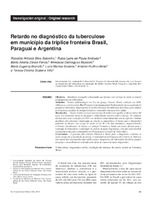Mostrar el registro sencillo del ítem
Retardo no diagnóstico da tuberculose em município da tríplice fronteira Brasil, Paraguai e Argentina
| dc.contributor.author | Silva-Sobrinho, Reinaldo Antonio | es_ES |
| dc.contributor.author | Andrade, Rubia Laine de Paula | es_ES |
| dc.contributor.author | Ponce, Maria Amélia Zanon | es_ES |
| dc.contributor.author | Wysocki, Anneliese Domingues | es_ES |
| dc.contributor.author | Brunello, Maria Eugenia | es_ES |
| dc.contributor.author | Scatena, Lucia Marina | es_ES |
| dc.contributor.author | Ruffino-Netto, Antonio | es_ES |
| dc.contributor.author | Villa, Tereza Cristina Scatena | es_ES |
| dc.date.accessioned | 2015 | |
| dc.date.available | 2015 | |
| dc.date.issued | 2012 | es_ES |
| dc.identifier.citation | Silva-Sobrinho, Reinaldo Antonio,Andrade, Rubia Laine de Paula,Ponce, Maria Amélia Zanon,Wysocki, Anneliese Domingues,Brunello, Maria Eugenia,Scatena, Lucia Marina,Ruffino-Netto, Antonio,Villa, Tereza Cristina Scatena (2012) Retardo no diagnóstico da tuberculose em município da tríplice fronteira Brasil, Paraguai e Argentina. Rev Panam Salud Publica;31(6) 461-468,jun. 2012. Retrieved from http://www.scielosp.org/scielo.php?script=sci_arttext&pid=S1020-49892012000600003 | es_ES |
| dc.identifier.uri | http://www.scielosp.org/scielo.php?script=sci_arttext&pid=S1020-49892012000600003 | es_ES |
| dc.identifier.uri | https://iris.paho.org/handle/10665.2/9313 | |
| dc.format.extent | tab | es_ES |
| dc.relation.ispartofseries | Rev Panam Salud Publica;31(6),jun. 2012 | es_ES |
| dc.subject | Tuberculose | pt_BR |
| dc.subject | Diagnóstico Tardio | es_ES |
| dc.subject | Avaliação de Serviços de Saúde | pt_BR |
| dc.subject | Saúde na fronteira | pt_BR |
| dc.subject | Brasil | pt_BR |
| dc.subject | Tuberculosis | es_ES |
| dc.subject | Delayed Diagnosis | es_ES |
| dc.subject | Health Services Evaluation | en_US |
| dc.subject | Border health | es_ES |
| dc.subject | Brazil | en_US |
| dc.subject | Diagnóstico Tardio | es_ES |
| dc.subject | Tuberculose | pt_BR |
| dc.subject | Argentina | es_ES |
| dc.subject | Brasil | pt_BR |
| dc.subject | Paraguai | es_ES |
| dc.subject | Tuberculose | pt_BR |
| dc.title | Retardo no diagnóstico da tuberculose em município da tríplice fronteira Brasil, Paraguai e Argentina | es_ES |
| dc.type | Journal articles | en_US |
| dc.rights.holder | Pan American Health Organization | en_US |
| dc.description.notes | OBJETIVO: Identificar os aspectos relacionados aos doentes e aos serviços de saúde no retardo do diagnóstico da tuberculose. MÉTODOS: Estudo epidemiológico em Foz do Iguaçu, Paraná, Brasil, realizado em 2009. Utilizou-se o instrumento The Primary Care Assessment Tool adaptado para a avaliação da atenção à tuberculose. Empregaram-se também técnicas de estatística descritiva, como análise de frequência, medidas de posição (mediana e intervalos interquartis) e odds. RESULTADOS: Houve retardo na busca por serviços de saúde entre aqueles na faixa etária 60 anos, sexo feminino, baixa escolaridade e conhecimento precário sobre a doença. As variáveis clínicas caso novo e infecção por HIV e as variáveis comportamentais uso de cigarros e bebidas alcoólicas não estiveram relacionadas ao retardo no diagnóstico. O tempo para o diagnóstico atribuído ao doente e ao serviço de saúde foi de 30 e 10 dias (mediana), respectivamente. O Pronto Atendimento 24 Horas e a Atenção Primária à Saúde não foram efetivos para a suspeição de tuberculose e solicitação de exames de apoio diagnóstico, com alto percentual de encaminhamento para o ambulatório do Programa de Controle da Tuberculose. CONCLUSÕES: A procura pela Atenção Primária à Saúde para o diagnóstico resultou em maior tempo até a descoberta da doença. O ambulatório do Programa de Controle da Tubercu lose apresentou desempenho mais efetivo para o diagnóstico da tuberculose devido ao preparo da equipe e ao acolhimento ordenado com oferta de exames de apoio diagnóstico.(AU) | pt_BR |
| dc.description.notes | OBJECTIVE: To identify the factors linked to patients and health services in delays in the diagnosis of tuberculosis. METHODS: Epidemiological study in Foz do Iguaçu, Paraná, Brazil, 2009. The Primary Care Assessment Tool, adapted for appraising tuberculosis treatment, was the instrument used. Descriptive statistics techniques were used, such as frequency distributions, central tendency and dispersion measurements (median and interquartile intervals), and odds ratios. RESULTS: There were greater delays in seeking health services for those in the age group 60 years and older, for females, for patients with low levels of education, and for patients with poor knowledge of the disease. Clinical variables (being a new case and HIV infection) and behavioral variables (use of tobacco and alcohol consumption) were not linked with delays in diagnosis. The median time delays before diagnosis attributable to patients and to the health services were 30 days and 10 days, respectively. Emergency 24-hour medical services and primary health care services were not effective in identifying suspicious cases of tuberculosis and requesting tests to confirm the diagnosis, with a high percentage of referrals to the Tuberculosis Control Program clinic. CONCLUSIONS: Going to primary health care services for diagnosis increased the time before diagnosis of the disease was reached. The Tuberculosis Control Program clinic was more effective in diagnosis of tuberculosis, due to the training of the staff and to an organized process for receiving patients, including the availability of tests to support the diagnosis.(AU) | pt_BR |
Ficheros en el ítem
Este ítem aparece en la(s) siguiente(s) colección(ones)
-
Pan American Journal of Public Health
Revista Panamericana de Salud Pública




